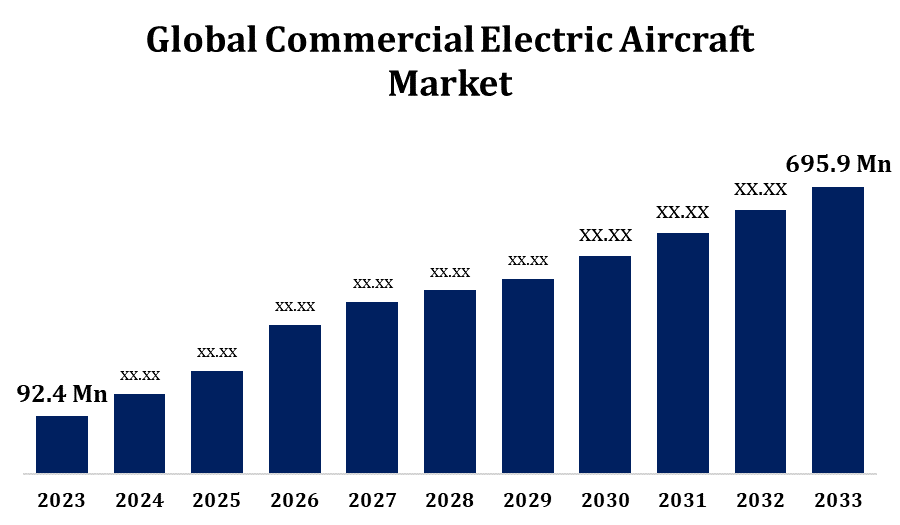Global Commercial Electric Aircraft Market Size To Worth USD 695.9 Million By 2033 | CAGR Of 22.37%
Category: Aerospace & DefenseGlobal Commercial Electric Aircraft Market Size To Worth USD 695.9 Million By 2033
According to a research report published by Spherical Insights & Consulting, the Global Commercial Electric Aircraft Market Size to grow from USD 92.4 million in 2023 to USD 695.9 million by 2033, at a Compound Annual Growth Rate (CAGR) of 22.37% during the forecast period.

Get more details on this report -
Browse key industry insights spread across 255 pages with 141 Market data tables and figures & charts from the report on the "Global Commercial Electric Aircraft Market Size, Share, and COVID-19 Impact Analysis, by Platform (Regional Transport Aircraft, Business Jets), Range (<200 Km, 200-500 Km, >500 Km), Power (100-500 kW, >500 kW), and By Region (North America, Europe, Asia-Pacific, Latin America, Middle East, and Africa), Analysis and Forecast 2023 - 2033." Get Detailed Report Description Here:https://www.sphericalinsights.com/press-release/nickel-alloys-market
The commercial electric aircraft market is swiftly progressing, fueled by advancements in battery technology, growing environmental concerns, and escalating fuel prices. These aircraft utilize electric propulsion systems, providing advantages like reduced carbon emissions, lower operating expenses, and quieter flights. Global governments and regulatory agencies are promoting the growth of sustainable aviation with incentives and strict emission targets, which further accelerates market expansion. Leading industry players are focusing on cutting-edge designs, hybrid-electric systems, and advanced battery technologies to enhance range and efficiency. Although electric aircraft are currently limited to regional and short-haul routes, the market is set to expand as battery capabilities improve. Despite challenges such as high initial costs and infrastructure demands, increasing investments and collaborations are overcoming these obstacles, positioning electric aircraft as a promising future for aviation.
Commercial Electric Aircraft Market Value Chain Analysis
The value chain of the commercial electric aircraft market involves several key stages, bringing together various stakeholders to deliver innovative solutions. It starts with raw material suppliers who provide critical components, such as lightweight materials and advanced battery elements. Technology providers are instrumental in developing propulsion systems, battery technologies, and energy management systems. Aircraft manufacturers design and assemble electric aircraft, integrating advanced technologies to improve range and efficiency. Regulatory authorities ensure adherence to safety and environmental standards, shaping market trends. Infrastructure developers, including those responsible for charging and maintenance facilities, ensure operational readiness. Finally, end-users, like airlines and charter services, adopt these aircraft to achieve sustainability objectives and reduce operational costs. Collaboration throughout this value chain fosters innovation, addresses challenges, and drives the ongoing growth of sustainable aviation solutions.
Commercial Electric Aircraft Market Opportunity Analysis
The commercial electric aircraft market offers substantial growth potential, fueled by advancements in battery technology, rising environmental awareness, and regulatory pressure to lower aviation emissions. Electric propulsion systems are particularly suitable for short-haul and regional flights, making these segments ideal for initial adoption. Additionally, emerging opportunities in urban air mobility and regional air transport are driving demand for innovative aircraft designs and services. Airlines are increasingly embracing sustainable practices, boosting the need for cost-effective and eco-friendly solutions. Technological progress in energy storage, lightweight materials, and hybrid-electric systems is improving performance and extending range. Furthermore, government incentives and investments in green aviation infrastructure, including charging stations, are accelerating market uptake. Partnerships among industry stakeholders and growing consumer demand for sustainable travel further enhance the market’s growth prospects.
The commercial electric aircraft market is witnessing significant growth, driven by the expansion of regional routes and increasing investments. Short-haul regional routes are particularly suited for electric aircraft due to their limited range and lower operational costs, providing airlines with an eco-friendly alternative to conventional planes. Investments in electric aviation technologies, such as advanced battery systems, lightweight materials, and hybrid-electric propulsion, are improving the performance and practicality of these aircraft. Both government and private sector investments are accelerating infrastructure development, including charging stations and maintenance facilities, to ensure operational readiness. Furthermore, collaborations between airlines, manufacturers, and technology providers are promoting innovation and expediting the commercialization process. With rising environmental concerns and regulatory pressures, these factors are fueling the adoption of electric aircraft, with regional routes playing a pivotal role in the market's expansion.
The limited energy density of batteries restricts the range and payload capacity of electric aircraft, making them most suitable for short-haul flights. High development costs and substantial initial investments in technology and infrastructure, including charging stations and maintenance facilities, present financial challenges. Regulatory obstacles and stringent safety standards complicate the development and certification process. The absence of a well-established charging network and the long charging times further reduce operational efficiency. Additionally, uncertainties surrounding the battery lifecycle, recycling, and disposal raise environmental and logistical concerns. Competition from traditional and hybrid aircraft, which offer longer ranges and well-established support systems, intensifies these challenges. To overcome these hurdles, ongoing innovation, greater collaboration, and supportive policies are essential for ensuring the long-term sustainability of the market.
Insights by Platform
The regional transport aircraft segment accounted for the largest market share over the forecast period 2023 to 2033. The growth of the market is fueled by the increasing demand for sustainable and cost-effective solutions for short-haul flights. Electric aircraft are ideal for regional routes due to their lower operating costs, reduced emissions, and quieter operations, making them appealing to both airlines and passengers. Advancements in battery technology and hybrid-electric propulsion systems are enhancing range and efficiency, further supporting the viability of regional transport. Government incentives and investments in green aviation infrastructure, including charging stations at regional airports, are speeding up adoption. Additionally, the rise of regional connectivity efforts, especially in developing regions, is opening up new opportunities for the deployment of electric aircraft. This segment is expected to play a crucial role in driving the market's growth and sustainability.
Insights by Power
The >500 kW segment accounted for the largest market share over the forecast period 2023 to 2033. This segment focuses on longer regional routes and emerging urban air mobility solutions, such as electric vertical takeoff and landing (eVTOL) aircraft. Thanks to advancements in high-power battery technology and hybrid-electric systems, aircraft in this segment can achieve enhanced range and efficiency, making them suitable for commercial use. Governments' emphasis on sustainability, combined with increased investments in green aviation infrastructure, is driving adoption. Airlines and aircraft manufacturers are dedicated to developing more powerful and efficient electric aircraft to meet environmental targets and lower operational costs. As technological progress continues, the >500 kW segment is set to play a pivotal role in shaping the future of sustainable aviation.
Insights by Range
The 200-500 km segment accounted for the largest market share over the forecast period 2023 to 2033. This range is well-suited to the current capabilities of electric aircraft, making it an ideal segment for electric propulsion systems, which offer lower operating costs, reduced carbon emissions, and quieter operations compared to conventional aircraft. Growing demand for eco-friendly air travel and government incentives aimed at reducing aviation's environmental impact are driving adoption in this segment. Advancements in battery energy density and hybrid-electric systems are enhancing range and efficiency, further improving the viability of electric aircraft for 200-500 km routes. Airlines are increasingly investing in electric aircraft for these routes to promote sustainability while providing competitive, cost-effective solutions. This segment is integral to the shift towards sustainable aviation.
Insights by Region

Get more details on this report -
North America is anticipated to dominate the Commercial Electric Aircraft Market from 2023 to 2033. The United States and Canada are leading the way in electric aviation, with a range of manufacturers, startups, and research institutions developing cutting-edge aircraft designs and propulsion systems. Supportive government policies, including incentives for sustainable aviation and strict emission regulations, are driving market growth. The region's advanced infrastructure and high demand for regional and short-haul flights provide a strong foundation for the adoption of electric aircraft. Growing collaborations between airlines, technology providers, and infrastructure developers are further boosting the market’s potential. North America's focus on reducing carbon emissions and achieving sustainability goals positions it as a key player in shaping the future of electric aviation.
Asia Pacific is witnessing the fastest market growth between 2023 to 2033. Japan, South Korea, and India are making significant investments in sustainable aviation technologies and infrastructure to tackle growing carbon emissions and urban mobility issues. The region's vast geographic diversity and demand for short-haul flights make it an ideal market for electric aircraft adoption. Collaborative efforts among governments, manufacturers, and technology providers are driving progress in battery technology and lightweight materials. While challenges like high initial costs and limited infrastructure remain, the Asia-Pacific's commitment to innovation, combined with strong economic growth, positions the region as a key driver in the global shift toward electric aviation.
Recent Market Developments
- In October 2023, Garmin has signed a long-term agreement to supply BETA Technologies with its advanced Garmin G3000® integrated flight deck for the CX300 electric fixed-wing aircraft and the A250 electric vertical takeoff and landing (eVTOL) aircraft.
Major players in the market
- Heart Aerospace (Sweden)
- Thales (France)
- Wright Electric Inc. (UK)
- Eviation (US)
- magniX (UK)
- Joby Aviation (US)
- Electric Aviation Group (France)
- Embraer (Brazil)
- Lilium (Germany)
- Vertical Aerospace (UK)
- ARCHER AVIATION INC.(US)
- Leonardo S.p.A. (Italy)
- Wisk Aero LLC. (US)
- SCYLAX GmbH (France)
- Overair, Inc. (US)
- Supernal, LLC (South Korea)
Market Segmentation
This study forecasts revenue at global, regional, and country levels from 2023 to 2033.
Commercial Electric Aircraft Market, Platform Analysis
- Regional Transport Aircraft
- Business Jets
Commercial Electric Aircraft Market, Range Analysis
- <200 Km
- 200-500 Km
- >500 Km
Commercial Electric Aircraft Market, Power Analysis
- 100-500 kW
- >500 kW
Commercial Electric Aircraft Market, Regional Analysis
- North America
- US
- Canada
- Mexico
- Europe
- Germany
- Uk
- France
- Italy
- Spain
- Russia
- Rest of Europe
- Asia Pacific
- China
- Japan
- India
- South Korea
- Australia
- Rest of Asia Pacific
- South America
- Brazil
- Argentina
- Rest of South America
- Middle East & Africa
- UAE
- Saudi Arabia
- Qatar
- South Africa
- Rest of the Middle East & Africa
About the Spherical Insights & Consulting
Spherical Insights & Consulting is a market research and consulting firm which provides actionable market research study, quantitative forecasting and trends analysis provides forward-looking insight especially designed for decision makers and aids ROI.
Which is catering to different industry such as financial sectors, industrial sectors, government organizations, universities, non-profits and corporations. The company's mission is to work with businesses to achieve business objectives and maintain strategic improvements.
CONTACT US:
For More Information on Your Target Market, Please Contact Us Below:
Phone: +1 303 800 4326 (the U.S.)
Phone: +91 90289 24100 (APAC)
Email: inquiry@sphericalinsights.com, sales@sphericalinsights.com
Contact Us: https://www.sphericalinsights.com/contact-us
Need help to buy this report?